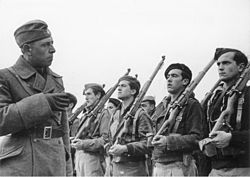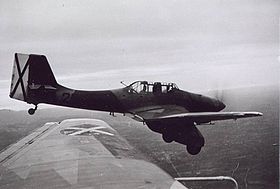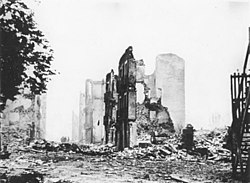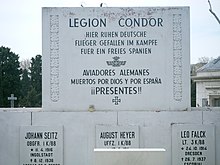Condor Legion
The Condor Legion (German: Legion Condor) was the name given to the mostly air intervention force that the Third Reich sent to the aid of Franco's forces to fight in the Spanish civil war. Adolf Hitler, German Chancellor, at the suggestion of the head of the Luftwaffe, Hermann Göring, and with the intention of testing the German air weapon in conventional warfare, secretly offered Franco air support for his land army. This help consisted of logistical support, transport of troops, supplies, tanks (especially Panzer I) and artillery, creating the first tank school, under the command of German Army Colonel Wilhelm von Thoma, in the Castle of Las Arguijuelas de Arriba in the vicinity of the city of Cáceres.
German intervention in the Civil War allowed Hitler to improve the quality of his aircraft and repair defects in his air weapon, preparing it for the global offensive he was planning. A normal attack could consist of a previous photographic flight. Next the bombers (about 80 German Junkers and Heinkels in 1936) were guarded by Italian fighters and more photographic capture planes. The accuracy of their bombs was amazing and reveals a detailed study of the targets. Over time, it proved to be one of the essential pieces in Franco's victory.
Background: The uprising of July 18
On July 18, 1936, a military rebellion broke out in the Spanish Protectorate of Morocco, which would end up degenerating into a true Civil War. The truth is that both the rebels and the government forces were not strong enough to defeat the contrary, but the problem of the rebels in Morocco was much more serious: the fleet had remained faithful to the government and controlled the waters of the Strait of Gibraltar with which the passage to the peninsula was cut off. Aircraft were needed, and the commander of the Army of Africa sent telegrams requesting help from the only international leaders likely to respond: Adolf Hitler and Benito Mussolini. The Italian dictator agreed to send a dozen transport devices and military supplies, while Hitler delayed his decision until the intervention of the then Reich Finance Minister, Hermann Göring. In Spanish Morocco there was an important businessman, Johannes Bernhardt, and it would be he who, under his influence, would constitute the figure in the shadows that wove German aid to Franco. Thus, through Operation magical fires (Unternehmen Feuerzauber) preparations for the Spanish adventure began, in which the Third Reich would use Spain as a particular firing range. On July 24 Bernhardt and Adolf Langenheim, the local leader of the NSDAP in Spanish Morocco, landed at Berlin-Tempelhof airport. Rudolf Hess, Adolf Hitler's secretary, arranged a meeting with the Führer the next day, at the Bayreuth Festival, after a performance of Richard Wagner's Sigfried.
On the night of July 25-26, in Bayreuth, Hitler's conversation with Langenheim and Bernhardt took place, who conveyed Franco's request to send transport planes, and finally the fundamental decision was made to support the Spanish general. Involved in the decision (in addition to Hitler) were Air Minister Göring and War Minister von Blomberg, who were also present in Bayreuth.
Political motivations for German intervention
In the first moments of the military uprising, Benito Mussolini had approved the shipment of arms, equipment and military supplies to the military rebels against the Spanish Republic, help that would later increase until the sending of a well-equipped army corps, the CTV. Hitler, although he hesitated more in his decision, in the end he did so by supporting the shipment of arms and supplies to Franco. And it is that, for Hitler there were a series of facts that would serve him in the future for his expansionist and militaristic policy:
- Franco's victory would represent a third unfriendly enemy (against Germany and Italy) on the borders with France.
- The internal tension that existed in France between the left and the right would be exacerbated by a civil war in Spain, a further reason for discussion between the two sectors. And this could serve in a weakening of the common position in front of Germany.
- The help of Italians in the Spanish conflict would keep the possibility of Western democracies attacking Italy (for fear of a war with Germany) and would further attract Italy to the Third German Reich.
- Wherever the military rebelled against the Republicans, Hitler could count a posteriori with the advantages of an allied Spain for the moment of the impending European conflagration.
Organization and composition of forces
Origins and official creation of the Expeditionary Corps
Between the end of July and the beginning of September 1936 there were different shipments of military material and technicians in support of the military rebels in the war, highlighting the shipment of Junkers Ju 52 to transport the African troops and some Heinkel He 51 fighters that gave a momentary control of the skies to the rebels.
However, the most important contingent left Germany on November 6 for Seville, the nucleus of what would become known as the Condor Legion, in an operation that received the code name Rügen Winter, commanded by General Von Sperrle and with Colonel Von Richtofen as Chief of Staff. The shipment contained aircraft, as well as anti-tank artillery, anti-aircraft artillery, and various tank sections. In total, the personnel of this primitive force numbered about 3,800 men, that number being increased shortly after to 5,000. In some respects, the Condor Legion was a revolutionary unit, although its equipment and weaponry were still very primitive; For starters, their planes almost always flew without radios and machine guns had to be loaded by hand. At that time, the bombers were still Junkers 52 and Heinkel 51 fighters, devices that, as would be shown later, were much heavier and slower than their Russian counterparts that were already beginning to arrive disassembled at the ports of Cartagena, Alicante and Valencia.
Ground Units
The original group was supported by units of anti-aircraft and anti-tank guns, as well as by two armored units made up of four companies, each made up of four Panzer I. Of the anti-aircraft teams, a part was attached to the units of the Luftwaffe as defense of the airfields while the rest remained as anti-aircraft defense of the ground forces. These forces were under the command of von Thoma, later a famous expert in armored warfare during World War II, who in Spain would be distinguished by the use of armored tactics later widely used during that war.
At his request and other German technicians, the first battle tank school would end up being created, under the command of Von Thoma, in the Castillo de las Arguijuelas de Arriba near the city of Cáceres. The Panzer I tanks were totally inferior to the Soviet T-26, despite the fact that some 200 tanks were sent in total. Von Thoma himself acknowledged in an interrogation of the Americans (at the end of World War II) that he had participated in some 192 tank actions throughout the entire Spanish war. During the Aragon offensive, von Thoma had to intervene before Franco's decision to distribute the tanks in the traditional military fashion. At that time the armored corps commanded by Thoma comprised four battalions, each with three companies, each of which was equipped with 15 light tanks. This body was likewise accompanied by thirty anti-tank companies, with six 37 mm cannons. each one.
Another elemental piece used by military teams (yes, both ground and air) was the use of the 88 mm Flak 18 cannon, a weapon that demonstrated its true capabilities in the war in Spain and would continue to do so more during the next war.
Naval Forces
The air and ground units of the primitive Condor Legion were later joined by a North Sea Group made up of specialists in naval artillery, mines and signals, operating from the pocket battleships Deutschland and Admiral Scheer. This fleet would be joined by the light cruiser Leipzig as well as some destroyers. Likewise, two submarines (the U-33 and the U-34) left for the Mediterranean to carry out secret missions, actually to train the new submarine crews. The presence of these ships caused many incidents: the U-34 would be responsible for the sinking of the Republican submarine C-3 off the coast of Malaga on December 13, 1936.
On the other hand, on the afternoon of May 26, 1937, the pocket battleship Deutschland was bombarded, causing more than twenty deaths and serious damage. Upon being informed of the events, Hitler He flew into a rage and ordered the bombardment of Valencia (then capital of the Republic). Advised by his military advisers, he decides to bombard the city of Almería. Thus, on May 31, the pocket battleship Admiral Scheer appeared together with four destroyers in front of the Andalusian port and fired two hundred shots against the defenseless city. The damage, both material and human, was numerous and Germany decided to withdraw from the naval patrols of the Non-Intervention Committee, a decision also followed by Italy.
Air Units
At the climax of the Battle of Madrid, on November 6, the bulk of the forces of the air components of the Condor Legion left Germany, the composition of the air forces (Luftwaffe) belonging to the Condor Legion, whose organization and composition was as follows:
Composition of air units (November 1936)
Condor Legion
Senior Commander: Generalmajor Hugo Sperrle
- Führungsstab S/88: General Staff
Air Units (Force of 136 aircraft):
- Jagdgruppe J/88: Hunting group with 4 Heinkel He 51 squadrons (48 planes).
- Kampfgruppe K/88: Bomber group with 4 Junkers Ju 52 squadrons (48 planes).
- Aufklärungsstaffel A/88: Recognition group with 4 squadrons:
- 3 Long-range reconnaissance squads equipped with Heinkel He 70 (18 planes).
- 1 Short-range action reconnaissance squad equipped with Heinkel He 45 (6 aircraft).
- Gemischte Aufklärungs- und Bombenstaffel See AS/88: Naval reconnaissance group consisting of 2 squadrons:
- 1 Squadron equipped with Heinkel He 59 (10 planes).
- 1 Squadron equipped with Heinkel He 60 (6 planes).
- Luftnachrichten-Abteilung Ln/88: Battalion of transmissions composed of four companies.
- Flak-Abteilung F/88: Anti-aircraft battalion equipped with six batteries.
- 2 batteries equipped with FlaK-30 of 20 mm (10 pieces).
- 4 batteries equipped with FlaK-18 of 88 mm (20 pieces).
- Luftzeuggruppe und Luftpark P/88: Two Luftwaffe maintenance companies.
- Munitions-Anstalt MA/88: Ammunition deposit
- Sanitäts-Abteilung San/88: Medical battalion
- Lazarett Laz/88: Field hospitals
- Wetterstelle W/88: Weather unit
As the war progressed, the number of planes that made up the Condor Legion increased, but the quality of its aircraft as well as its pilots and technicians also increased. After Franco's defeat at Madrid, the Germans saw the need to increase shipments of material and men. Faced with the prospects of a long war, they sent their best weapons to be tested at the private Spanish firing range. By the end of the war, the Germans had sent some 600 aircraft to Spain, including 136 Messerschmitt Bf 109 aircraft, 125 Heinkel He 51 aircraft, 93 Heinkel He 111 and 63 Junkers Ju 52 aircraft. another 20 Heinkel He 46 aircraft, as well as 31 Dornier Do 17 aircraft and 5 Junkers Ju 87, the later famous Stuka.
Barracks and airfields of the Condor Legion
- Aerodrome de Tablada (Sevilla).
- Santo Tomé headquarters.
- Military airfield of León, headquarters.
- Aerodromo finca Las Migueras-Villa del Prado.
- Aerodrome of La Albericia (Santander).
- Pontejos airfield (Cantabria).
- Cenia airfield (Tarragona).
Operation history
From the crossing of the strait to the battles for Madrid
At the beginning of the battle of Madrid, the first important contingent of troops and equipment of the primitive Condor Legion arrived. Once installed in Spanish bases (the seaplane section did so in Palma de Mallorca, while the rest of the units in the Iberian Peninsula) the air units dedicated themselves to strategic bombardments of Madrid (already started by the insurgents, now continued by the Germans) with increasing intensity. The truth is that the German military advisers sought to see the behavior of the Madrid population in the face of this type of bombing and its reaction. The operations after the assault on Madrid (especially during the fighting in Jarama) meant a failure for Franco because he could not subdue the capital, but for the Condor Legion it was a whole field of learning in the large-scale use of modern weapons in a land battle that tactically had not changed much since the First World War.
After the Italian defeat in Guadalajara, the squadrons of the Condor Legion would move to the northern front and would only return to the center for the Republican Counterattack in Brunete. Here the Republican troops managed to achieve significant initial success but, as usual in their offensives, this was exhausted after a few days. And the rebellious counterattack was joined by the air response of the Condor Legion, which with the presence of the new Messerschmitt Bf 109 and the Heinkel He 111 granted absolute control of the air to the insurgents, and Brunete was reconquered again. The losses of the Condor Legion were minimal compared to the damage inflicted on the Republican aviation.
Northern Campaign
Madrid was a very tough nut to crack for Franco, so he set his eyes on the northern front, militarily weak and politically disunited. The German squadrons were moving towards the Bay of Biscay when the bombardment of Durango took place, the prelude to another in which the future Lutfwaffe would participate.
The bombing of Guernica
The Operation Rügen —as the bombing of Guernica was codenamed— on April 26, 1937 was the first time that the action of the German air force caused a large number of civilian casualties. The Germans had been practicing new techniques (“Carpet Bombing”), hitherto unseen, on isolated targets such as the Golpejar Factory Bombing (days before the bombing of Guernica). Orders were given to the pilots to bomb the bridge of Rentería and the Basque city of Guernica, populated by 7000 inhabitants. The bridge, which was the main military objective of the aerial bombardment, was paradoxically saved. The operation led to scathing international condemnation. It was then that international attention focused on the involvement of Nazi Germany and Fascist Italy in the conflict. Until then, the German policy of military aid and technical personnel had been publicly denied or silenced. It was publicly communicated with the bombing, in accordance with the position of neutrality that it had declared during the signing of the Non-intervention Pact, although neither France nor Great Britain reacted in this regard.
Subsequently, this destruction has received wide media coverage and has created an international perception of what German participation in the Spanish conflict was like. The Franco regime, faced with international rejection, always tried to deny its participation in the bombing and accused the Republican side of being responsible for the destruction of the Basque town, a clear allusion to what happened during the battle of Irún the previous year. He later acknowledged that the Republican side had not been responsible, although he warned that only German officers are responsible for the attack, despite the fact that his staff had approved it, in accordance with the terror tactics of masses used in Bilbao, Madrid and Barcelona. However, the participation and degree of knowledge that the rebel side had regarding the planning of the attack has never been fully clarified. The Basque Government at the time estimated the victims of the bombardment at 1,654 dead and 889 wounded —unprecedented in bombardments of civilian targets to date. The publication of these figures sparked an international outcry, which would be the inspiration for Pablo Picasso's painting Guernica, which has since become an icon of the horrors of war. The bombing of Guernica shows, in a way, how General Franco's fascist forces in Spain had come to depend to a great extent on the expertise of German and Italian pilots, but also how independently they acted with respect to the rebels.
Aragon and Levante
The Ebro and Catalonia
Military and other prominent participants
- Hermann Aldinger.
- Oskar Dirlewanger.
- Rudolf Demme.
- Adolf Galland (1912-1996). He arrived in Spain in the middle of 1937, quickly assuming the command of the 3rd Caza Group (3.J/88). He participated actively in combat, developing tactics and combat techniques, until in 1938 he returned to Germany.
- Hajo Herrmann.
- Günther Lützow (1912-1945). He was sent to Spain in early 1937, assuming command of 2.J/88. He participated in the bombing of Guernica.
- Werner Mölders (1913-1941). Commander of Squadron in command of the 3rd Caza Group (3.J/88). It was the first As of the Condor Legion with 14 victories.
- Eduard Neumann.
- Wolfram Freiherr von Richthofen. Chief of Staff of the Condor Legion and then Commander-in-Chief of it, from October 1938 until the end of the conflict.
- Hugo Sperrle (1885-1953). First Commander of the Condor Legion, until October 1, 1937. His nickname was "Sander."
- Karl Schweikard.
- Wilhelm von Thoma (1891-1948). German armoured forces organizer in 1934. He was the head of the German instructors assigned to the Nationalist Army and also the armoured forces added to the Condor Legion.
- Hannes Trautloft (1912-1995). He was one of the first pilots of the Condor Legion to the peninsula.
- Hellmuth Volkmann (1889-1940). Commander of the Condor Legion from 1 November 1937 until October 1938. Nicknamed "Veith."
- Heinrich Ehrler (1917-1945). Belonging to the anti-aircraft battalion of the Condor Legon, but that during the Second World War it would become an Ace of fighters, with 208 accredited downhills.
- Walter Warlimont (1894-1976). Lieutenant Colonel of the Wehrmacht, he was sent to Spain to act as a liaison between the Reich War Ministry and the revolted authorities, and also as head of the German volunteers deployed in Spain. He emphasized his reports to the initial superiority of the republican field in planes and tanks, as well as the need to strengthen Franco in these aspects by sending an expeditionary force.
- Chiang Wei-kuo (foreign commentator).
Economic implications: German business in Spain
Bernhardt: The key to German intervention
Johannes Bernhardt was a German businessman who had emigrated from Germany to Spain before the war during the Great Depression, settling in the Spanish Protectorate of Morocco. There he had done great business in it, extending his network of influence among some economic and military sectors.
HISMA and ROWAK
The Hispano-Moroccan Transport Society (HISMA) was a shell company incorporated in Tetuan on July 31, 1936, controlled by the Nazi Party and whose purpose was to serve as a cover for arms trafficking for the Francoist side during the Spanish Civil War. His work was essential in the operation to transfer part of the Army of Africa to the Iberian Peninsula. He also organized the first German contingent on the Francoist side. Hitler's aid to Franco, which he received through HISMA, was compensated through exports through another fictitious German company created by order of Hermann Göring, ROWAK (Rohstoff und Wareneinkaufgesellschaft). However, who really controlled all economic operations in Spain was Johannes Bernhardt.
Consequences of the intervention
Economic costs and participation data
In 1939, German shipments had been made in 180 expeditions throughout the war. The German forces present during the Spanish Civil War numbered at most about 10,000 men, although some 14,000 veterans participated in the Berlin parade in May 1939. The Germans who helped the insurgents probably numbered more than 16,000, many of whom were civilian personnel and instructors. However, the core of these was the Condor Legion, and this was always composed of no more than 5,000 in number. effective. Of the entire group, some 300 Germans died during the war.
The Condor Legion from the Spanish postwar period to the present day
The Spanish Cross (Spanienkreuz) was the decoration given to veterans of the Condor Legion by the Nazi authorities since April 14, 1939. Due to the nature secret of German activities in Spain during the war, until then no official decoration had been awarded by the German military authorities, although some German soldiers had received decorations from the Franco authorities in gratitude for their services during some military operations. Some members of the Condor Legion participated in the Victory parade held on May 19 in Madrid, as well as in the air rally that took place at the Barajas airport on the 12th of the same month. On May 22 they had a lavish farewell (a torchlight parade was held the night before) at the La Virgen del Camino aerodrome, where five thousand legionnaires marched until they ended up in the cathedral of León, with the assistance of personalities such as the head of the Air Force Alfredo Kindelán or Bishop Carmelo Ballester. The events were presided over by the already dictator Franco, who thanked the help of the German legions to defeat "the communist scum of Europe" in Spanish territory and thus stressed its decisive importance for the win:
I have always considered the "Condor Legion" as one of the institutions of our crusade.
On May 24, they left Spain from the port of Vigo, parading through the streets of the city in another spectacular fascist-style military parade. After leaving the peninsula aboard several ships (including the later famous KS Wilhelm Gustloff), were well received in Germany, especially during a military parade on June 6 attended by Hitler himself. With the beginning of the Second World War, a large part of the volunteers who had fought in Spain had an outstanding performance in it, especially Richthofen, Sperrle, Von Thoma or Galland. Others, like Werner Mölders, would die during the war.
Until the early 1990s, there was no active recrimination movement in the FRG for the activities of the Condor Legion in Spain and the presence of German citizens among those who carried out the bombing of Guernica. In 1997, on the 60th anniversary of Operation Rügen, the then President of the Republic Roman Herzog wrote a letter to the survivors of the bombing in which he publicly apologized on behalf of the German people and state. Herzog expressed that he wanted to extend a hand of friendship and reconciliation on behalf of all German citizens. This sentiment has since been ratified by members of the German Parliament who in 1997 approved the removal of all members of the Condor Legion that were named in the German military records to heroic soldiers.
Fonts
References
Contenido relacionado
Annex: Archery at the 1980 Moscow Olympics
Eastern Cape Province
Mayorga









